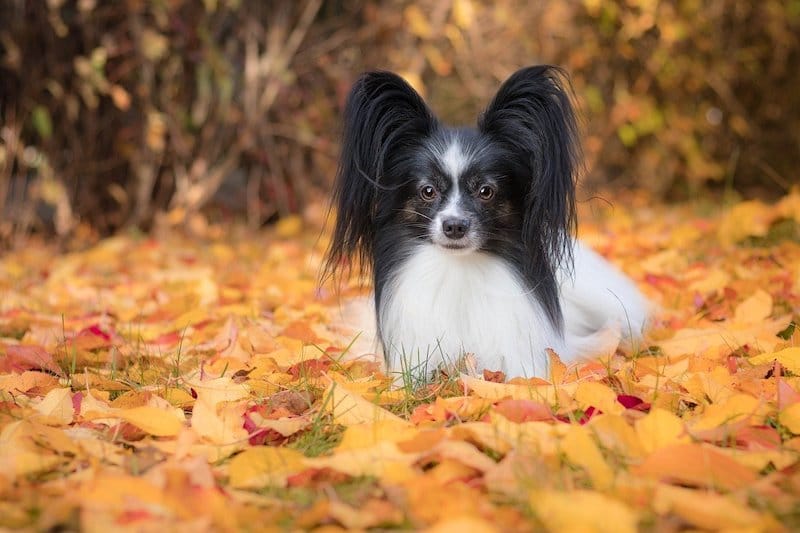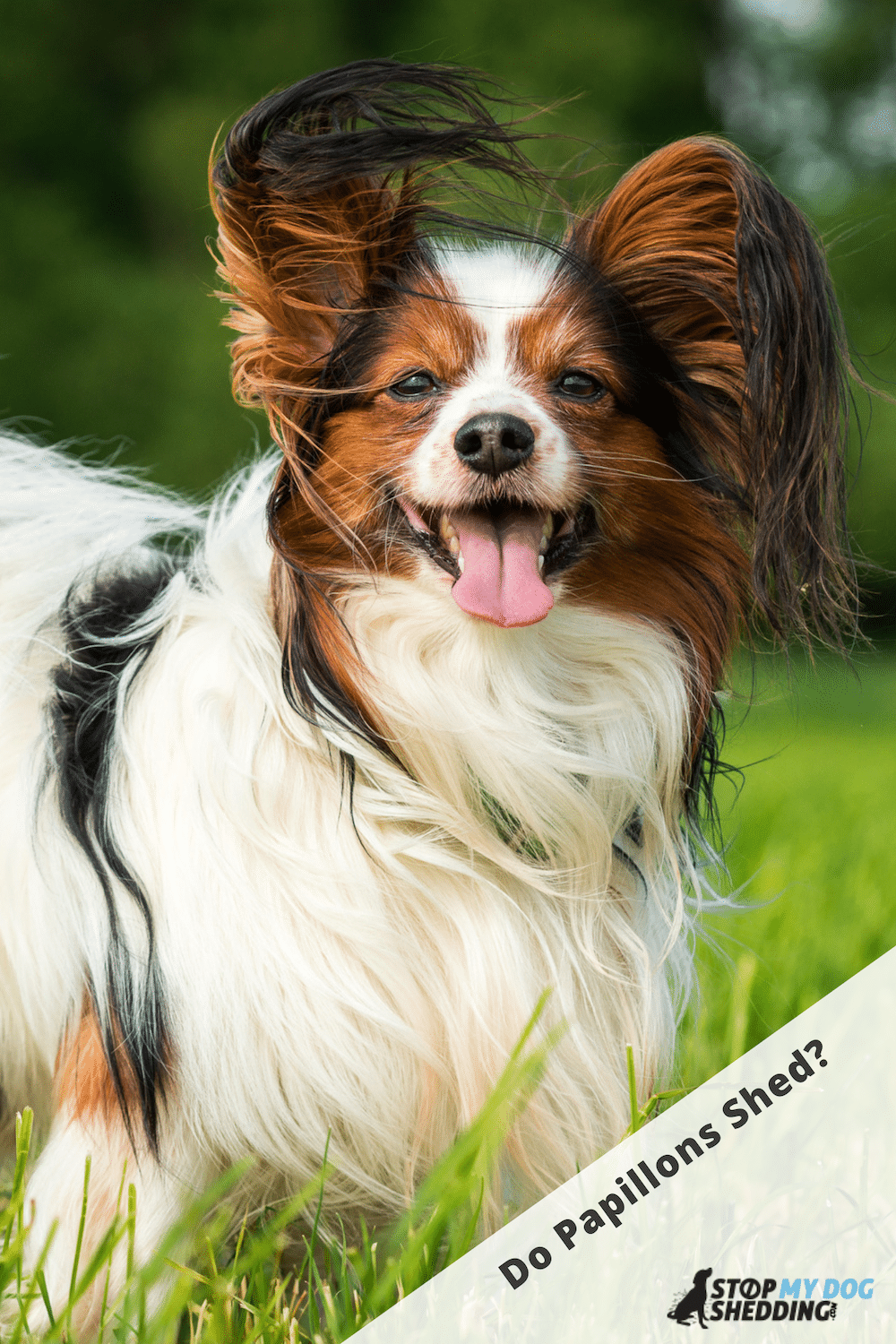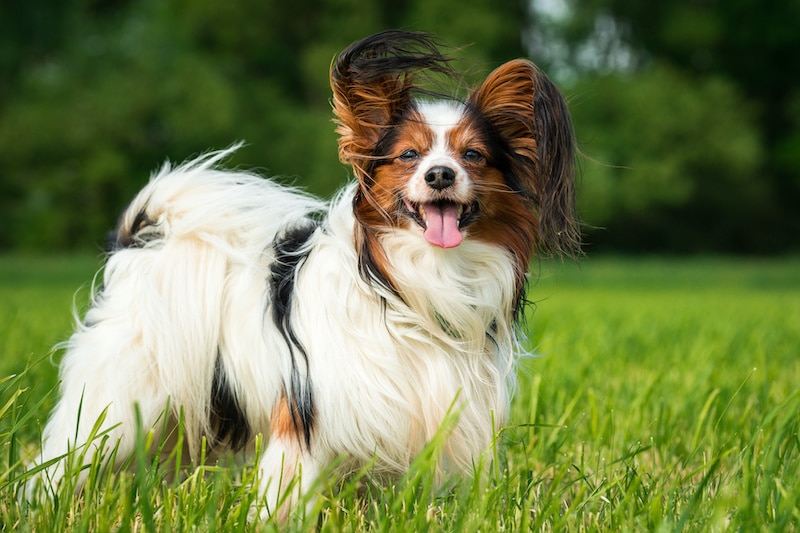Papillons are small, beautiful looking dogs that were bred as companions for noblewomen hundreds of years ago. Today, the friendly and upbeat Pap is a popular family companion. And don’t let their cuteness fool you, they’re actually very athletic, robust little dogs!
And thankfully, they don’t shed much at all.
Papillons have long, silky, flowing coats that shed very little. And they’re not very difficult to groom either, so maintaining their coat and keeping your home free from dog hair is a matter of brushing once or twice a week with a slicker brush or metal comb.
Let’s take a closer look at how much Paps shed and what it takes to keep their coat in good shape, so you know what to expect if you decide to adopt.
Papillon Shedding – What to Expect
Papillons are a low shedding breed.
You will notice some hair dropping out throughout the year, but nothing too extreme. Overall it isn’t very noticeable and is very manageable.
They shed about the same as dogs like the Maltese and Shih Tzu. But not quite as much as the Pomeranian, which is another popular toy breed. And, unlike Pomeranians, Papillons have a single coat. Meaning, they only have one layer of hair instead of two (an outer coat and undercoat).
Double coated dogs tend to shed their undercoat once or twice per year quite heavily, so the fact that Papillons lack an undercoat means they don’t shed as heavily during seasons like spring and fall.
It does depend on the individual Pap, and you may notice some increase in shedding during spring, but the molting they do is normally more evenly spread throughout the year.
Another factor that can cause your Pap to shed more heavily than normal is their diet. It’s worth ensuring you are feeding your dog an optimal diet and one that encourages a strong, healthy coat. As this can make a difference as to how much molting they do.
There’s no such thing as a dog food that completely eliminates shedding, but good quality dog food can make a difference.
Other factors such as stress, fleas and flea related allergies can also have an impact on shedding. So, while a bit of molting is normal, speak with your veterinarian if you have any concerns.
Recommended: Go here to see our top-rated dog hair blow dryers
Grooming Your Papillon
Grooming a Papillon isn’t as difficult as it looks.
Normally, long-haired dogs are high maintenance when it comes to grooming, but this isn’t the case with a Pap.
For the most part, the occasional bath and brushing once or twice per week is enough to maintain their coat and remove any dead hairs from their coat.
What sort of brush is best for a Pap?
As with any dog, what brush is best depends on what type of coat they have. The type of brush you would use on a longer coated dog is different from the one you’d use on a smooth coated dog for example. So it depends on the dog.
Papillons have an abundant single coat made up of fine, silky, flowing hair that is shorter and flatter lying in some areas, like the back and sides. And longer and more profuse in other areas, such as the chest and ears.
As a side note, the way the hair flows around their ears is actually a distinct feature of this breed. Front on, they have a butterfly-like appearance given the shape and length of the hair around their ears. And, according to Wikipedia, this is what led to their name, Papillon, which means butterfly in French where they originate.

Anyways, given the longer hair, and the fact that they don’t have an undercoat, a slicker brush or metal comb is ideal. A slicker brush is made up of fine wire bristles with protective plastic tips on the ends and helps to remove any tangles, knots and mats she may have accumulated, as well as remove any dead hairs.
And because they are single-coated, and don’t shed much, you don’t really need a deshedding tool or anything too heavy. A slicker or comb work just fine.
Related: Different Types of Dog Grooming Brushes
Brushing isn’t just a good way to remove mats and old, dead hairs from their coat. It also helps to distribute their skin oils which promotes healthier hair growth. So it’s well worth doing a few times per week.
Besides brushing, Paps only need the occasional bath, like every few months or so, especially since they’re not a particularly smelly dog.
And when you do bathe her, be sure to use a good quality dog shampoo. Using low quality shampoos or those that are designed for humans can dry out their coat. And in turn, lead to skin dryness and irritation, which can actually increase shedding.
Recommended: Go here to see our top-rated dog hair blow dryers
Bottom Line
Papillons are small, single-coated dogs that don’t shed much. And overall, they’re pretty easy to groom. The occasion bath and weekly brush is normally enough to maintain their coat and keep your home fur-free.
So they’re ideal if you’re looking for a low shedding, easy-to-groom dog.
However, they are not considered to be a “hypoallergenic dog breed” by the American Kennel Club. Which means, while there are far worse dogs an allergy sufferer could choose, dogs like the Poodle or Italian Greyhound may be more suitable in this respect.
Read next: Dog Shedding FAQ (Helpful Guide)













Please note: By submitting a comment using the above comment form, you confirm that you agree with the storage and handling of your data by this site as detailed in our Privacy Policy.